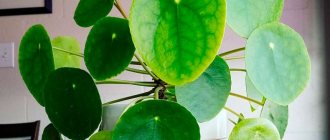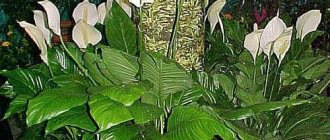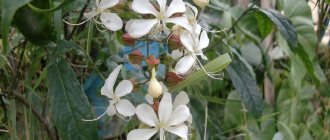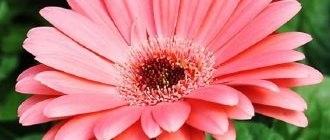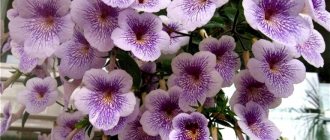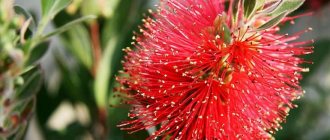Fatshedera is the name of a vine obtained by crossing two plants: ivy and Japanese fatsia. This species is named after the Liese brothers, who bred it in 1912 in France. Subsequently, the plant received the name Fatshedera Liese (Litsa) and was classified as a member of the Araliaceae family. Flower growers immediately appreciated the decorativeness, bright greenery and unpretentiousness of the plant. They began to use it for landscaping terraces and winter gardens. This flower was liked by lovers of indoor plants, and further you can learn about caring for it at home.
Features of fatheaders
Fatshedera is essentially a rare exotic plant. Quite a short time after this vine was created, it became very popular among both florists and gardeners. It is often used to decorate flower arrangements, and is also quite often grown on terraces, balconies and winter gardens. And such a flower looks great in a spacious hall or foyer.
Fatshedera is distinguished from other plants by its large dark green glossy leaf blades, which are similar to the foliage of ivy and fatsia. Throughout the entire period of foliage growth, its color does not change. The length of the leaf plate is about 30 centimeters, and its width is approximately 20 centimeters. Their shape can be finger-lobed or trifoliate. Very often, in fatshedera subspecies, along the edge of the leaf blade there is an irregular border of white or cream color, thanks to which the plant becomes even more spectacular and elegant.
The length of the bush can reach about 5 meters. At first it looks like a tree with a semi-lignified, weakly branched stem. If there is a desire, then the vine can be constantly grown in the form of a tree, but for this you will need to install a support (bamboo or wooden stick). If you pinch the shoots of the tree, then you can form a shrub that will delight you with its gorgeous green foliage for a long time. If there is no support, then the shoot will begin to creep, and over time it will become more like a vine. As it grows, the stem becomes woody, and dark brown bark appears on its surface. Over the course of a year, such a plant increases in length by 0.3–0.4 m.
In adult Fatshedera, in the last summer or first autumn weeks, the formation of umbrella-shaped flowers is observed, which can be colored cream or yellowish-green. Such flowers are part of paniculate inflorescences. At the end of flowering, dark blue berries are formed on the bush. This plant is highly hardy and can be grown in open ground, but only those regions where winters are mild and not too cold are suitable for this. When choosing a place for a vine, keep in mind that it needs a lot of bright light.
Description
Young plants of this species have smooth and easily bendable stems, which are covered with hard and rough bark at a more mature age. Since fatshedera is a vine, it often requires support for active growth, because sometimes the height of the trunk reaches 5 meters! The leaves of the vine are divided into 3-5 parts and have a dark green color. There are representatives with lighter frames.
The flowering period occurs at the end of summer and beginning of autumn. Then flowers of delicate pastel colors appear on the branches. The plant bears fruit in a small size with berries of various shades of blue.
Selecting a location
In order for the Fatshedera to grow and develop normally at home, it needs to create optimal conditions.
Illumination
This evergreen vine does best in a location with plenty of bright light. However, it can also be grown in shade. The optimal level of lighting in indoor conditions is slight shading. In the spring-summer period, if possible, fatshedera is recommended to be grown in open ground; for this, it can be planted in the garden or transferred in a pot to the balcony. A shady courtyard is perfect for such a plant. However, the choice of location must be taken very seriously, as it must be protected from direct sunlight. The fact is that the scorching sun can burn the leaf blades of the plant.
Humidity and temperature conditions
Fatshedera has a fairly high resistance to temperatures observed from spring to autumn. However, if the room is hotter than 25 degrees, the plant will become lethargic and temporarily lose its decorative effect.
In winter, it is recommended to keep the vine in a cool place (from 10 to 15 degrees). The air humidity level is maintained at a moderately high level. If the room becomes too hot (18 degrees and above), then the foliage on the bush must be moistened with a spray bottle, creating something like a warm shower. By the way, it is recommended to carry out a similar procedure from time to time throughout the year in order to remove accumulated dirt and dust on the leaf plates. This procedure also has an antibacterial effect. It is advisable to moisten the plant in this way once a week. In addition, remove dust from the foliage weekly using wet wipes. Protect the vine from cold air currents and drafts, as they can greatly harm it.
Fatshedera care at home
You need to care for indoor fatshedera in almost the same way as other flowers growing at home. It must be watered, pruned, fed and replanted in a timely manner.
How to water
In the spring-autumn period, such an evergreen vine needs abundant watering, which should be done quite often. However, make sure that there is no stagnation of liquid in its root system, otherwise this may cause the development of root diseases. Some time after watering, be sure to drain the excess liquid that has accumulated there from the pan. In winter, the plant is watered much less frequently and less abundantly.
Depending on the air temperature in the room, the plant is watered with the following frequency:
- at a temperature of 24–26 degrees – once every two to three days;
- at a temperature of 20–24 degrees - the substrate in the pot is moistened once every 5 or 6 days;
- if the temperature in the room is kept at 16–18 degrees, then watering is carried out once every 7–10 days;
- if the room is quite cool (12–15 degrees), then you need to moisten the soil mixture in the pot no more than once every 30 days.
But remember that you cannot allow the earthen clod to dry out completely, no matter what the air temperature in the room is. Do not forget to loosen the surface of the soil mixture in the pot once every 15–20 days.
You can understand that there is stagnation of fluid in the root system by the foliage, which turns yellowish. If the vine needs urgent watering, then this can be guessed by the leaf plates that have lost turgor, which will fall down, and the shape of the crown will also change.
It is recommended to water the Fatshedera with well-settled or rainwater, the temperature of which should be close to room temperature. It is not recommended to water such a vine in the usual way; drip irrigation is best suited for this, which, if desired, can be combined with moistening the bush with a spray bottle.
When planting fatsheders, do not forget to make a good drainage layer at the bottom of the pot. It should occupy a third of the total volume of the container. And on top it is covered with an earth mixture consisting of 2 parts turf soil, 1 part sand and 1 part humus. To create drainage, it is recommended to use small pieces of brick or small expanded clay.
Fertilizer
It is necessary to systematically feed this evergreen vine only during the period of its intensive growth, which is observed from the first days of April to the second half of September. For fertilizing, both organic and mineral complexes are used, and these fertilizers are recommended to be used alternately. Fertilizers are added to the soil mixture regularly: 2–3 times a month. In winter, when the vine has a dormant period, there is no need to feed it.
You can find fertilizer for such a plant in a specialized store. To do this, you will need fertilizer for decorative foliage indoor plants, for example: “Vympel-2”, “Master Elite”, “Alliance”, “Agricola”, “Bona Forte”, etc.
Trimming
A similar vine, grown indoors, is very flexible and elastic. However, if it is not pruned in a timely manner, then it may develop one powerful central stem, while the side shoots will develop very poorly. This may cause the vine to lose its attractiveness. After the height of the bush is thirty centimeters, the first pruning is carried out, this is necessary in order to stimulate the growth of side shoots. Remember that in some cases, even with optimal growing conditions and good care, side shoots will practically not develop even after pruning, while the bush itself will be oppressed and weakened.
In order for your home to be decorated with a spectacular thick vine, it is recommended to plant 2 or 3 seedlings in one container at once, and do not forget to trim regularly.
Transfer
Until the young bush is five years old, it should be replanted once a year. Older plants are replanted less frequently, or rather, once every 2–3 years, and the top layer of soil mixture in the pot must be replaced every year. However, if you want your vine to always be thick and spectacular, then replant once a year, regardless of its age.
The pot for transplanting should be chosen not very wide, but high. Thanks to this, even a thick drainage layer will not interfere with the development of the root system. When replanting, do not forget that the old flower pot should be 20–30 mm smaller in diameter than the new one.
Experts advise replanting fatshedera in early spring (approximately in the first days of April), before the bush begins to actively grow. The substrate must be neutral or low acidity. It is recommended to replant the vine using the transshipment method, while trying not to destroy the earthen lump.
At the very beginning, you need to prepare a suitable container, and then the substrate. When there are two to three days left before replanting, you need to regularly moisten the soil mixture in the pot, but for this you need to use a small amount of water. Thanks to this preparation, the earthen lump will remain intact during transplantation. Next, remove the bush along with a lump of earth from the old container. To make it easier to remove the earthen lump from the container, place it on a hard and flat surface and lightly knock on its edges. Instead, you can take a long knife and run it along the inside of the container, trying to separate the soil mixture from the walls of the pot. After this, grasping the base of the vine, it is carefully pulled out. To harm the plant as little as possible, turn the container on its side.
After the bush is removed from the pot, inspect its root system for rot or signs of disease. If you notice signs of rot or any disease, then carefully remove all the substrate, being careful not to injure the roots. After this, use a sharp, sterilized instrument to cut out all damaged areas, and sprinkle the cut areas with charcoal powder. If the roots are healthy, then carefully remove the top layer of the old soil mixture, as well as the drainage layer along with the roots grown into it. Then place the bush in a new pot, and make a drainage layer at the bottom in advance. After the fatshedera is placed in a new container, all voids in it must be carefully filled with fresh soil mixture. Do not forget that the distance from the top layer of the substrate to the top edge of the container should be from 30 to 50 mm.
It is necessary to water the transplanted vine correctly. Since the substrate was regularly moistened for 2-3 days before transplantation, after it is transplanted, it does not need to be watered immediately. Wait 1 to 3 days, during which time the plant will dry out and heal any wounds on the roots that may have appeared during the replanting process.
Flowering, pruning fatsia
Indoor Aralia blooms on rare occasions. Flowering lasts throughout June-August. Flowers - openwork umbrellas are collected in paniculate inflorescences and do not differ in decorative appearance, but they attract with their delicate aroma. In autumn, the plant is strewn with small dark blue berries.
Fatsia pruning is usually done once after replanting to form the crown of young plants. Only young plants are pruned in the first 3 years of life. In older specimens, any pruning worsens the appearance and makes the plant less impressive. Fatshedera is more demanding when it comes to pruning, which is pruned 4–5 times a year. In addition, to determine the shape of the plant, tweezing (pinching the top) is done.
This procedure should be treated with caution: touching the leaves of the flower can cause an allergic reaction.
Fatsia in most cases does not need support. It happens when wilted leaves are laid out on spreader sticks so that they become elastic again. The walls of the house can serve as support for the plant.
More often, support is selected for fatshedera, since this plant has a long, thin trunk. It is supported by pillars, grilles, arches, and shop windows.
Table: correcting mistakes in fatsia care
| What happens to the plant | What to do to correct the situation |
| Young leaves have turned yellow |
|
| Leaves wither | Adjust watering to avoid overwatering or drying out. |
| The leaves are turning pale | Adjust the lighting so that there is no lack or excess of light. |
| Leaves are drying |
|
| A gray coating appeared on the stems, the leaves darkened |
|
| Small leaves, new ones do not grow |
|
| brittle leaves | Increase air humidity. |
| Shriveled leaves | Do not expose the leaves to direct sunlight. |
Reproduction methods
Fatsheders use several methods for propagation, namely: seeds, cuttings and air layering.
Cuttings
This plant can be propagated by cuttings in the warm season. The best time for this is the last weeks of spring or the first weeks of summer. Prepare cuttings about 15 centimeters long; to do this, cut off the apical shoots. For rooting, they are planted in a soil mixture consisting of 1 part humus, 2 parts turf and 1 part sand. Cover the cuttings with a transparent bag on top, which will help create greenhouse conditions. After new buds form on the cuttings, the bag is removed.
Reproduction by air layering
It is relatively easy to propagate Fatshedera by air layering, which is why this method is most popular among gardeners. This procedure begins in the first days of April. Select one leafless side shoot and lightly cut it. Then moistened moss is placed in the area of the incision, and film is wrapped on top of it. If the sphagnum is damp all the time, then after about a couple of months roots will form at the cut site. When this happens, part of the shoot with horses must be cut out and planted in a pot with soil mixture. In order for air layering to quickly take root in a new place, it should be systematically watered. And in order for rooting to be successful, the top of the cutting is covered with a glass jar or a transparent bag; the cover can be removed after a week.
Growing from seeds
Fatshedera can also be grown from seeds, but they must be freshly harvested. To do this, the seeds formed on an adult vine are collected and used for sowing. Take a small container, fill it with soil mixture and place the seeds on its surface, which are not buried, but only lightly sprinkled with substrate on top. For seed germination, greenhouse conditions are needed; for this, the crops are covered with glass or film on top. After this, the crops are transferred to a dark place where the air temperature is constantly kept at 27 degrees. If everything is done correctly, the first seedlings should appear after 4 weeks.
How to propagate
“Frenchwoman” is propagated by cuttings, seed method, and also by air layering.
Cuttings
It is carried out in warm times, best in late spring - early summer. To do this, cut off the apical shoots 15 cm long, place them in a container with a substrate made from turf, humus and sand (2/1/1), and create greenhouse conditions, that is, cover them with film. Once the buds appear on the cuttings, the film can be removed.
Air layering
The simplest and most popular method of culture propagation. They begin this procedure in early April. The leafless stem of one of the shoots is cut slightly, wet sphagnum is applied to the cut site and the whole thing is wrapped in film. Provided that the moss is always wet, after 2 months new roots will appear on the cut part of the stem. Then the part of the stem covered with roots is cut out and placed in a pre-prepared pot with substrate.
In order for a new plant to take root well, the soil underneath must be regularly moistened. It is also worth taking care of high air humidity: cover the young plant with film or even a glass jar (for 7 days), which also contributes to its rapid rooting.
Seeds
This method is carried out using exclusively freshly collected seed material (the seeds ripen on an adult plant and can be collected independently at home). Fresh fruits are placed in the substrate without being buried, sprinkled with a little soil and greenhouse conditions are created using film, glass or a bag. Then the container is placed in a warm (+27°C) and dark room and wait for the shoots to appear after a month.
Possible difficulties
When cultivating Fatshedera indoors, the grower may encounter the following problems:
- The tops of the leaf blades turn yellow, and they themselves become brittle and dry, and spots also appear on them . This is due to the fact that the vine is not watered often enough or very sparingly. And the foliage may lose its decorative effect if the bush is in the heat (above 25 degrees). To correct the situation, you need to water the bush more often, and you will also need to increase the level of air humidity. If large brown spots appear on the surface of the foliage, and it itself begins to wrinkle, this means that the bush was exposed to direct rays of the sun, which caused burns. The way out of the situation is to shade the vines from direct sunlight.
- The foliage becomes faded and loses its shine . This happens when the fatsheder does not have enough light. In this case, the bush is moved to a place with brighter lighting.
- The liana quickly fades, and a gray fluff forms on its surface . This happens if the room is extremely cold and the humidity is very high. Move the bush to a place where both the temperature and humidity level would be optimal for this plant. Then trim off any wilted leaves and loosen the surface of the soil mixture in the pot. After this, the bush is treated with a solution of a fungicidal drug.
Remember that in an adult vine the leaf blades may fly off as they grow older and this is quite normal.
Diseases and other growing problems
The hybrid type of fatsheder is resistant to diseases. Problems arise from non-compliance with the conditions of detention. Let's look at the most common questions that gardeners have.
| Sign | Cause | Treatment methods |
| The edges of the leaves dry out. | Lack of moisture | Eliminate errors in fatheader content. |
| The leaves are wrinkled. | Dry air | |
| The leaves turn yellow and begin to fall. | Excess moisture in the soil | |
| Dry brown spots appear on the leaves. | Sunburn. | |
| Variegated leaves lose their brightness. | Insufficient lighting. | |
| Powdery mildew appears on the leaves, and the roots begin to rot. | Frequent and abundant watering, leading to stagnation of water in the pot. | If the roots rot, it is necessary to replant the plant and cut off the diseased roots. If only the leaves are affected, then treat with fungicides. |
| During wintering in a cold room, a gray fluffy coating (gray rot) appears. | Hypothermia of the plant. | Diseased shoots are removed, the vine is treated with fungicides and transferred to a warmer place. |
Meaning for home
Since fatshedera was created using ivy, it adopted not only some genetic characteristics, but also some signs and superstitions. For example, it is believed that fatshedera has an extremely negative effect on men, causing aggression and negative energy in them. There is also an opinion that this vine can survive the man from the apartment, and it’s good that if he leaves, otherwise he may die. If there is such a plant in the apartment, the man will try to leave it as quickly as possible or will not even want to enter it. In addition, both ivy and fatshedera are considered “energy vampires”, absorbing happiness, self-confidence, optimism and peace of mind.
But the bad qualities of such a plant appear only when it is grown indoors. If you plant it in the garden, then on the contrary it will be a reliable protector of the residents of the house. Thanks to him, negative energy will not enter your home.
However, some superstitious people believe that, on the contrary, this vine is very useful, no matter where it is grown. It helps cleanse the biofield of the apartment, and also has a beneficial effect on the thoughts and character of the residents, and instills in them confidence and peace.
Types of fatsheders with photos
Fatshedera has the following decorative varieties:
Variegata
The dark green leaf blades have a yellow or cream edging. This variety is characterized by fast growth, but poor resistance to pests and diseases.
Piya
The entire bush is covered with not very long bright green leaf plates, their edges are variegated and wavy, tightly adjacent to the shoot.
Silver Prince
This spectacular variety has a silver border on each leaf blade.
